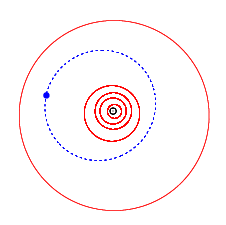Discovered by K. Reinmuth MPC designation 1000 Piazzia Observation arc 93.25 yr (34,058 days) Aphelion 3.99 m Discoverer Karl Wilhelm Reinmuth | Discovery date 12 August 1923 Minor planet category main-belt · (outer) Discovered 12 August 1923 Orbits Sun | |
 | ||
Alternative names 1923 NZ · 1951 OB1967 ED Discovery site Landessternwarte Heidelberg-Königstuhl Similar 1002 Olbersia, 1001 Gaussia, Asteroid belt, Sun, Solar System | ||
1000 Piazzia, provisional designation 1923 NZ, is a dark asteroid from the outer region of the asteroid belt, approximately 48 kilometers in diameter. It was discovered on 12 August 1923, by German astronomer Karl Reinmuth at Heidelberg Observatory in southern Germany.
Piazzia orbits the Sun at a distance of 2.4–4.0 AU once every 5 years and 8 months (2,063 days). Its orbit has an eccentricity of 0.26 and an inclination of 21° with respect to the ecliptic. As no precoveries were taken, the body's observation arc begins with its first recorded observation on the night following its official discovery date.
After Piazzia had been published by The Minor Planet Bulletin as an opportunity for photometry in 2001, a classically shaped bimodal light-curve was obtained at the Santana Observatory (646) in Rancho Cucamonga, California. The light-curve gave a rotation period of 7000947000000000000♠9.47±0.01 hours with a brightness variation of 0.45 magnitude (U=3). A second light-curve was obtained by astronomer René Roy in March 2007, rendering a period of 7000919999999999999♠9.2±0.2 hours and an amplitude of 0.2 magnitude (U=2).
According to the space-based surveys carried out by Infrared Astronomical Satellite IRAS, the Japanese Akari satellite, and the NEOWISE mission of NASA's Wide-field Infrared Survey Explorer, Piazzia measures between 47.8 and 51.6 kilometers and its surface has an albedo between 0.041 and 0.112. The Collaborative Asteroid Lightcurve Link (CALL) derives a low albedo of 0.046 (in accordance with AKARI) and a diameter of 47.2 kilometers (in accordance with IRAS), based on an absolute magnitude of 10.6. Although CALL derives an albedo of less than 0.05, it classifies the body as a S-type rather than a carbonaceous C-type asteroid.
The minor planet was named in honour of Italian Theatine monk Giuseppe Piazzi (1746–1826). He was a director of both the Palermo Observatory and Naples Observatory, known for the compilation of the Palermo Catalogue, containing the precise position of 7,646 stars. In 1801, Piazzi discovered 1 Ceres, the first and largest asteroid and the main-belt's only dwarf planet. He is also honoured by the lunar crater Piazzi (H 96).
